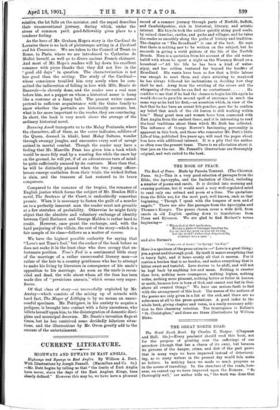C ITRRENT LITERAT URE.
HIGHWAYS AND -BYWAYS IN BAST ANGLIA.
Highways and Byways in Bast Anglia. By William A. Dutt. With Illustrations by Joseph Pennell. (Macmillan and Co. Os.) —Mr. Dutt begins by telling us that "the limits of East Anglia have never, since the days of the East Anglian Kings, been clearly defined." However this may be, we have here a pleasant
record of a summer journey through parts of Norfolk, Suffolk, and Cambridgeshire, rich in historical, literary, and artistic interest. His bicycle took the author quickly along good roads, by ruined churches, castles, and parks and villages, and he takes the reader as smoothly along the paths of history and tradition. The chapter on "The Broadland" is one of the best. He says that there is nothing new to be written on the subject, but he succeeds in giving a vivid picture of the life of the Norfolk Broads. Here is a quotation from his account of the old water- bailiff with whom he spent a night on the Waveney Broad on a houseboat :—" All his life he has been a kind of winer- gipsy, and has seldom ventured far beyond the bortters of Broadland. His wants have been so few that a little labour was enough to meet them, and since attaining to manhood he has always followed his inclinations in deciding how they shall be met. Away from the swirling of the rivers and the
whispering of the reeds he can find no contentment He confides to me that if he had the chance to begin his life again he would choose to pass his second spell of existence in much the same way as be had his first,--an assertion which, in view of the fact that he has been an arrant fish-poacher, goes- far to confirm my belief that much of the old leaven is still working within him." Many great men and women have been connected with East Anglia from the earliest times, and it is interesting to read the local traditions about them which Mr. Dutt has collected. The influence of George Borrow's fascinating personality is apparent in this book, and those who remember Mr. Dutt's little Life of him, published five years ago, will read the pages about him here with additional interest. It is a pity that the author so often uses the present tease. There is an affectation about it that jars on the ear. Mr. Pennell's illustrations are thoroughly original, and well suited to the book.






































 Previous page
Previous page